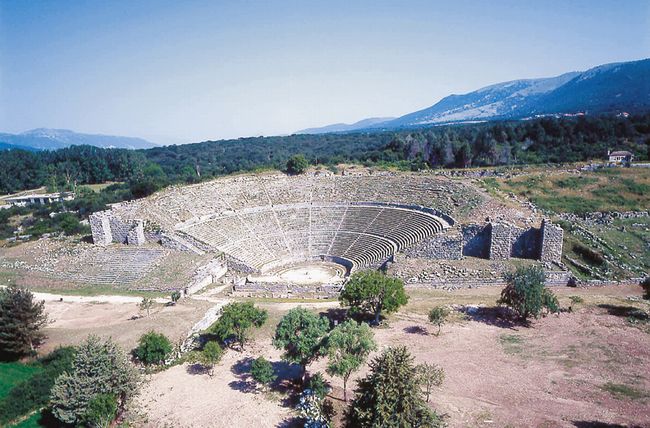The ancient theatre of Dodoni, located in the Epirus region of northwestern Greece, is one of the country’s best-preserved and most significant archaeological sites. Built during the 3rd century BCE, the theatre was a vital part of the sprawling sanctuary of Dodoni, an important cultural and religious centre dedicated to Zeus and Dione.
Historical and Cultural Context
Dodoni was one of the oldest oracles in ancient Greece, predating even the famous Oracle of Delphi. The site was a sacred place for worship and prophecy, where priests interpreted divine messages from the rustling leaves of a sacred oak tree. The theatre was built as part of a broader expansion of the sanctuary during the rule of King Pyrrhus of Epirus (319–272 BCE), who sought to enhance Dodoni’s prominence and infrastructure.
The theatre served as a venue for religious festivals, dramatic performances, and athletic contests, primarily during the annual Naia festival in honour of Zeus. Over time, it became a focal point of social and cultural life in the region.
Architectural Features
The theatre of Dodoni is a masterpiece of Hellenistic architecture. It was carved into the slope of Mount Tomaros, taking advantage of the natural landscape to create its vast semicircular seating area (koilon). The theatre could accommodate approximately 17,000 spectators, making it one of the largest in ancient Greece.
Key architectural features include:
- Koilon (Seating Area): Divided into three horizontal zones with a series of stairs for access. The rows of seats offered spectators an unobstructed view of the performances and the surrounding scenery.
- Orchestra: The circular space at the base of the theatre where the chorus performed. Its design facilitated excellent acoustics, ensuring that even spectators in the upper tiers could hear clearly.
- Skene (Stage Building): Though not as well-preserved as the seating, the stage structure originally served as a backdrop for performances and a place for actors to prepare.
Later Modifications and Usage
The theatre underwent significant modifications during the Roman era. The orchestra was partially transformed into an arena to host gladiatorial contests and other Roman spectacles, a common practice in theatres repurposed during Roman rule. These changes reflect the shifting cultural priorities of the time.
By the 4th century CE, the site had declined due to invasions and earthquakes and was eventually abandoned. Over time, much of the theatre was buried, and its stones were repurposed for local construction.
Modern Restoration and Significance
Systematic theatre excavations began in the early 20th century, uncovering its grandeur and role within the sanctuary of Dodoni. Restoration efforts have since been undertaken to stabilize and partially reconstruct the structure, allowing visitors to appreciate its scale and significance.
Today, the theatre of Dodoni is part of a UNESCO-listed archaeological site, attracting historians, archaeologists, and tourists. In recent years, it has also been revived as a performance venue for ancient Greek dramas and concerts, blending its historical legacy with modern cultural events.
Visiting the Theatre
The ancient theatre is surrounded by other significant remains of the sanctuary, including the sacred oak grove, the foundations of the Temple of Zeus, a bouleuterion (council chamber), and residential buildings. The site’s serene mountain setting adds to its mystique, offering visitors a chance to connect with both history and nature.
The theatre of Dodoni stands as a testament to ancient Greek architectural ingenuity and cultural richness, embodying the enduring legacy of one of Greece’s most sacred and storied sites.




